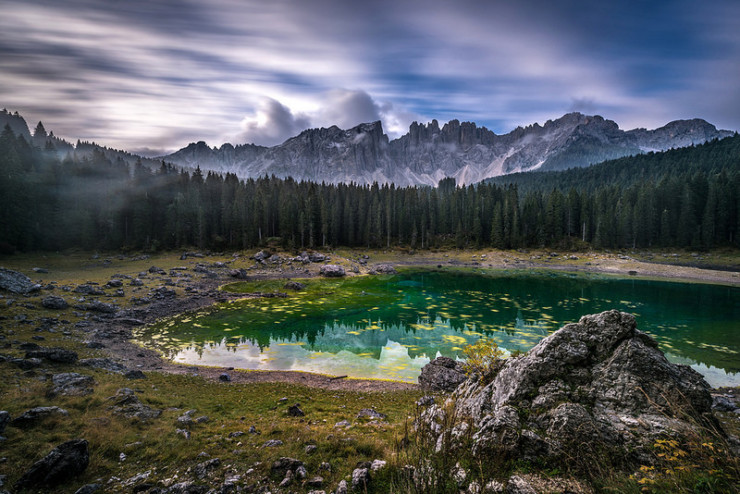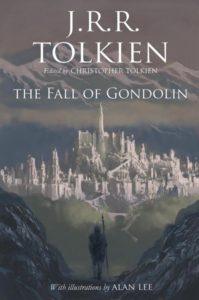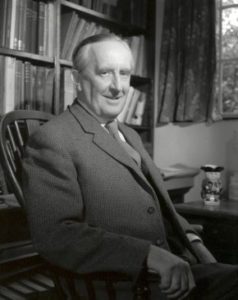
Gondolin is a city created by elves, hidden away in the mountains, the last outpost of light in the First Age of Middle-earth, when the evil forces of Morgoth have conquered almost everything else. Morgoth knows this city must exist, and he regularly sends search parties of orcs to find it. Its end is almost inevitable, and the story of that end is told in The Fall of Gondolin, the last of the unpublished tales of J.R.R. Tolkien.
Opposing Morgoth is Ulmo, the god of the sea, who raises up Tuor of the race of men. Tuor undertakes three great journeys in his life.

The second is his journey to Gondolin, where he comes to live and marry Idril, the daughter and only child of the elvish king. Tuor and Idril have a son, Earendil, who, outside the arc of this story, will have a son named Elrond of Rivendell, a main character in The Lord of the Rings.
Tuor’s third great journey will be to lead his family and a small remnant of the elves of Gondolin to safety, after the destruction of the city.
And thus ends one of the great publishing stories of modern times, a story that began in 1937 with The Hobbit, crested in the 1950s with The Lord of the Rings trilogy, and then continued after Tolkien’s death with the publication of The Silmarillion in 1977, the 12 volumes of The History of Middle-earth (1983-1996), and the three stories of the First Age — The Children of Hurin (2007), Beren and Luthien (2017), and now The Fall of Gondolin, just published August 30.
That we have all of these stories since The Lord of the Rings is due to Tolkien’s son and literary executor Christopher Tolkien, who has served as editor for all of his father’s publications since Tolkien’s death in 1973. Christopher also edited his father’s non-Middle-earth stories, poems, and translations, including The Legend of Sigurd and Gudrun (2009), The Fall of Arthur (2013), and Beowulf: A Translation (2014). What Christopher, now 94, has accomplished is no small feat; all of these posthumous works have required extensive editing, research, and text comparisons.

J.R.R. Tolkien
Christopher Tolkien says that his father began to write The Fall of Gondolin in 1916 or 1917, during World War I. The text version he uses for this publication was written longhand by his father in 1925 and typed by his mother, Edith. But to publish it properly required comparison of texts, versions, notes, and other materials, and Christopher describes it the book (the story itself is 57 of the 304 pages).
The edition includes eight plates of illustrations by artist Alan Lee, which are both true to the spirit of Tolkien and his artwork and a profound reinterpretation.
The Fall of Gondolin includes trademark Tolkien themes and devices. We see the unleashing of dragons, balrogs, and orcs against the city of the elves. We watch the treachery of the king’s nephew. We read the great battle scenes at which Tolkien excelled. And we experience the sorrow and determination of the hero, in this case the man Tuor, leading the few survivors to safety. (Tolkien always managed to save a remnant, a pointed reminder that, in the long run, superior numbers are not always decisive.)
It’s a heart-stirring story. It’s also evidence, as if we needed more, of what one man’s imagination produced.
Related:
“The Fall of Arthur” by J.R.R. Tolkien
Tales of the First Age: “Beren and Luthien” by J.R.R. Tolkien
“The Children of Hurin” and “The Lay of Aotrou and Itroun” by J.R.R. Tolkien
Poets and Poems: J.R.R. Tolkien and “Beowulf”
Poetry Date: Sisters Read Tolkien and One Wears Dagger
Making fantasy reality: Alan Lee, the man who redrew Middle-earth – The Guardian
Photo by Diana Robinson, Creative Commons, via Flickr. Post by Glynn Young, author of Poetry at Work and the novels Dancing Priest, A Light Shining, and the newly published Dancing King.
__________________________

“I require all our incoming poetry students—in the MFA I direct—to buy and read this book.”
—Jeanetta Calhoun Mish
- Finding Poetry in an Anselm Kiefer Art Exhibition - November 25, 2025
- Poets and Poems: Autumn Williams and “Clouds on the Ground” - November 20, 2025
- The Manuscript of “The Waste Land” by T.S. Eliot - November 18, 2025
Laura Lynn Brown says
I wonder whether an imagination like that is still possible.
Glynn Young says
Some point to writers like J.K. Rowling. But, as creative and imaginative as the Harry Potter stories are, they don’t envision an entire world on the scale that Tolkien did. It’s hard to approach what he did, including the invention of alphabets and languages.
Sandra Heska King says
I’m a little afraid of letting my imagination loose. Otherwise, I’d probably be right up there with J.R.R. Just think… JRR+SHK. Snicker.
Glynn says
Instead of Middle-earth, you could have Middle-Florida, with gators instead of orcs and pythons instead of balrogs. With all those birds, you could call it The Lord of the Wings.
Sandra Heska King says
I. Can’t. Breathe.
Wait… that might be a good idea…
Megan Willome says
Yes, I think the invention of languages sets Tolkien apart.
Just read a nice article on another author who leans in the imaginative direction, George R.R. Martin, singing Tolkien’s praises. The video is especially good: http://www.latimes.com/books/la-et-jc-george-rr-martin-tolkien-20180813-story.html#
Glynn says
Good article, Megan.
Tolkien inspired many, many fantasy writers.
Katie says
Cheers to:
J.R.R. Tolkien, author extraordinaire
Christopher Tolkien, editor who preserved a legacy
Edith Tolkien, who typed JRRT’s long hand manuscript
Alan Lea, an exquisite illustrator
& to our very own Glynn – a toast: for these posts which show us what
imagination, creativity, vision, doggedness, and skill can yield.
Gratefully,
Katie
Glynn says
Katie – thank you!
Diane Stephenson says
I am in the middle of The Silmarillion right now and thoroughly enjoying it. I also have, but not yet read, The Book of Lost Tales. I have read TLOTR at least 3 times and watched the trilogy many times. The Hobbit I have read so many times I wouldn’t have any idea of the number. Tolkien had an almost child-like scope in his imagination and that, coupled with the maturity of life experience, his Christian stance, academic study, knowledge and literary ability, in my opinion sets him apart from all others. Thank you for sharing about the publication of this final book.